Table of Contents
Socotra Island is a breathtaking destination located in the Arabian Sea, off the coast of Yemen. It is known for its stunning landscapes, abundant wildlife, and diverse plant species. The island is also home to the famous Dragon Blood Tree, an unusual tree species. This Socotra travel guide provides an overview of the island, its history, culture, and key tourist attractions.
Interactive Socotra map below. Click the yellow dots to show photo and description.
Socotra Island Interactive Map
Socotra Island Map
Socotra Island
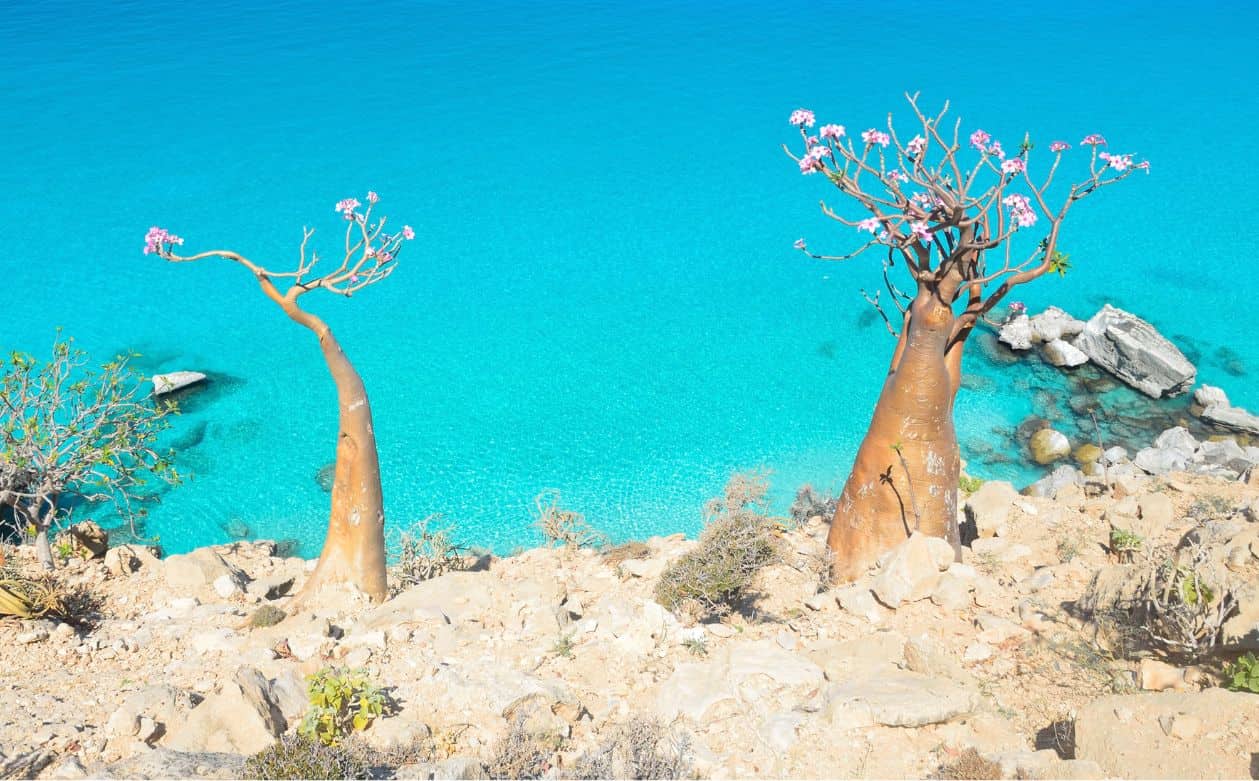
Introduction to Socotra Island
Socotra Island in Yemen is a unique gem in the Arabian Sea. This island boasts a breathtaking landscape filled with diverse plant and animal species, including the famous endemic Dragon Blood Tree.
With its crystal clear waters, pristine beaches, and diverse culture, Socotra Island is an unforgettable destination for nature lovers and adventure seekers alike. From eco-tours to scenic hikes, this island offers a variety of activities that highlight its unique beauty and rich history. Get ready to be transported to a world unlike any other and explore the wonders of Socotra Island.

A Brief Glimpse of Socotra:
- Socotra is a UNESCO World Heritage site and one of the World’s most unique and biologically diverse places.
- Socotra is considered one of the most remote islands in the world and has a long history of human habitation, with evidence of human settlement dating back over 2,000 years.
- The island has a unique landscape, with high cliffs, sandy beaches, and diverse vegetation that includes strange-looking dragon blood trees and other endemic species.
- The island is known for its rich culture and history, with ancient tombs, caves, and ruins that are open to visitors.
- Socotra is located in the Indian Ocean and is part of Yemen, although it is closer to the coast of Somalia.
- The island is known for its high levels of endemism, with over 700 species of plants and animals found only on Socotra.
- The island has a rich cultural heritage, with a mix of African, Arab, and Indian influences, and is home to several unique traditions and festivals.
- Socotra is a popular destination for eco-tourism and adventure tours, with opportunities for hiking, snorkeling, and birdwatching.
- Because of its remote location, the island is not very well-connected, and there are no regular flights from the mainland of Yemen or international flights. There are only two weekly flights, one from Al Mukalla and another one from Abu Dhabi.
Socotra Island is renowned for its unique and diverse array of endemic plant species. From the famous dragon blood tree, to the unusual bottle tree, to the captivating desert rose, the island’s flora is truly one of a kind.
Visitors can explore the lush forests, barren deserts, and pristine beaches to witness these remarkable species in their natural habitats. The flora of Socotra Island is a testament to the island’s significance as a biodiversity hotspot, and provides a window into the incredible diversity of life on our planet.
Whether you’re a botanist or simply someone who appreciates nature, the unique plants of Socotra Island are sure to leave you in awe. So bring your hiking shoes and get ready to discover one of the world’s most fascinating ecosystems!
The significance of Socotra Island
Socotra Island is a unique and significant destination for many reasons. Its remote location has allowed for the evolution of a unique ecosystem, which includes a high number of plant and animal species found nowhere else on the planet. This includes the famous Dragon Blood Tree, a species that is exclusive to the island. The island’s diverse geography, ranging from lush forests to barren deserts, adds to its natural beauty and significance.

Additionally, Socotra Island has a rich cultural history, with a distinct language and traditional way of life that has been passed down through generations. These factors all contribute to the significance of Socotra Island, making it a destination unlike any other. Whether you’re a nature lover, history buff, or just seeking a break from the familiar, Socotra Island is a destination that is not to be missed.
Location of Socotra Island

Socotra Island is located in the Arabian Sea, approximately 240 km east of the Horn of Africa and 380 km south of the Arabian Peninsula. It is part of an archipelago of four islands and is the largest of the group.
This unique location in the Indian Ocean sets the stage for the island’s stunning natural beauty and rich biodiversity, making it a must-visit destination for those seeking adventure and a break from the hustle and bustle of city life.
If you’re wondering where is Socotra island, it’s located off the coast of Yemen and waiting to be explored. This Socotra holiday destination or Socotra trip opportunity is perfect for families who want to do something extraordinary and immerse themselves in a new culture and natural world. Book your “travel to Socotra” adventure today and experience the beauty of this unique and fascinating destination.
Curiosities about where is Socotra
- Socotra is located in the Indian Ocean, near the coast of Yemen.
- It is part of the Socotra Archipelago and consists of four islands.
- The archipelago is situated approximately 240 km east of the Horn of Africa and 380 km south of the Arabian Peninsula.
- It is considered a remote island, with limited transportation options and infrastructure.
- Socotra has a unique geography, with diverse landscapes ranging from deserts and caves to tropical forests and beaches.
- The island is of volcanic origin and is considered a hotspot of biodiversity due to its isolation from mainland Africa.
- The island’s location has also made it a strategic point for shipping and military operations in the past.
Socotra Archipelago

The Socotra Island is part of the Socotra Archipelago, which is officially one of the governorates of Yemen.
The archipelago consists of four large islands: Socotra, Abd al Kuri, Samha, and Darsah, and three small islets. The Socotra Governorate is divided into two districts: Hidaybu, which covers the eastern two-thirds of Socotra Island, and Qulensya wa Abd al Kuri, which covers the western third of Socotra Island and the other three islands.
If you’re looking for a truly unforgettable travel experience, consider taking one of the “socotra tours” or “socotra trek tours” offered on the island. Whether you prefer a scheduled tour or a private one, the options are available from September to May. You’ll get the chance to explore the stunning beaches, try “socotra fishing,” and discover the unique plant and animal life that can only be found on Socotra.
Geography and Climate
Socotra Island is characterized by its unique and diverse geography, with landscapes ranging from lush forests, to barren deserts. The island is also home to a number of unique rock formations, caves, and beaches, making it a haven for outdoor enthusiasts. The climate on Socotra Island is tropical and arid, with temperatures ranging from 25°C to 35°C.

The island experiences two main seasons, the cool and dry season from November to March, and the hot and humid season from April to October. This climate, combined with its location in the Indian Ocean, creates the perfect conditions for the growth of the island’s unique flora and fauna.
During the cool season, temperatures are pleasant and comfortable, making it an ideal time to explore the island’s unique landscapes and beaches. The hot and humid season is characterized by higher temperatures and more frequent rainfall, which can make outdoor activities more challenging.
However, the rain provides a much-needed source of moisture for the island’s unique flora and fauna, making it a crucial part of the island’s ecosystem. Regardless of the season, the weather on Socotra Island is always warm and inviting, making it a perfect destination for those seeking a tropical getaway.

Socotra Island boasts a unique topography that is as diverse as it is stunning. The island is dominated by a central plateau, with towering cliffs, caves, and rock formations that are perfect for exploring. The coastline is dotted with serene beaches, crystal-clear waters, white sand dunes, and vibrant coral reefs that are teeming with marine life.
The interior of the island is home to deserts and barren landscapes, as well as lush forests and rolling hills.
Best time to visit Socotra
The beautiful island of Socotra has two vastly different weather patterns that travelers should take into consideration when planning their visit. From June to early September, the island experiences a windy monsoon season, characterized by high winds that raise sand and dust in the air, making hiking and outdoor activities difficult. This season is also hot, making it an unfavorable time for visitors.
In contrast, the rainy monsoon, which takes place from November to early January, brings heavy downpours that can cause damage to the island’s delicate roads. Although the bulk of rainfall occurs in December, travelers may experience storms in October, November, and January.
Despite the risks, this season is a beautiful time to visit, as the lush greenery of the trees is a sight to behold. For those who enjoy trekking, October and early November are excellent times to explore the Hajhir Mountains. However, oceanic activities such as snorkeling and diving may not be as enjoyable due to larger swells and cloudy water.
The ideal time to visit Socotra is between February and May, when the weather is mild, the water is calm and clear, and the island’s beautiful blooms are in full display. During this season, temperatures are pleasant and outdoor activities can be fully enjoyed. However, as the months progress towards May, the dryness of the season can result in haze and arid conditions. If you want to see the most flower blooms on the island, January and February are the best months to visit.
Wildlife and Flora
Socotra Island is a biodiversity hotspot, with a rich array of wildlife and flora that is found nowhere else on Earth. The island is home to a wide variety of endemic species, including the famous dragon blood tree, the unique desert rose, and the curious bottle tree. The wildlife on Socotra Island is equally impressive, with rare species such as the Socotra cormorant and the blue baboon tarantula calling the island home.

Whether you’re admiring the lush forests or exploring the barren deserts, the wildlife and flora of Socotra Island will leave you in awe. This unique and diverse ecosystem is a testament to the island’s significance, and provides a window into the incredible diversity of life on our planet.
Socotra Island is home to a diverse range of unique and fascinating animals that are found nowhere else on Earth. From the Socotra blue baboon tarantula, to the Socotra cormorant, to the various species of reptiles and birds, the island’s wildlife is truly a sight to behold.
10 Unique Animals Found on Socotra Island with Scientific Names:
- Socotra Rock Gecko (Tarentola recebiana)
- Socotra Sunbird (Nectarinia balfouri)
- Socotra Starling (Onychognathus frater)
- Socotra Sparrow (Passer insularis)
- Socotra Warbler (Sylvia laferreri)
- Socotra House Bat (Taphozous aureus)
- Socotra Chameleon (Chamaeleo monachus)
- Socotra Lizard (Trapelus dhara)
- Socotra Skink (Eumeces socotranus)
- Socotra Sand Lizard (Pedioplanis socotrana)
Visitors can witness these rare and intriguing Socotra Island animals in their natural habitats, such as the beaches, forests, and deserts. With its pristine landscapes and thriving ecosystem, Socotra Island offers a truly unforgettable wildlife experience.
Whether you’re a seasoned naturalist or simply a curious traveler, the Socotra animals are sure to captivate and inspire you. So pack your binoculars and get ready for an adventure like no other!
Socotra Animals





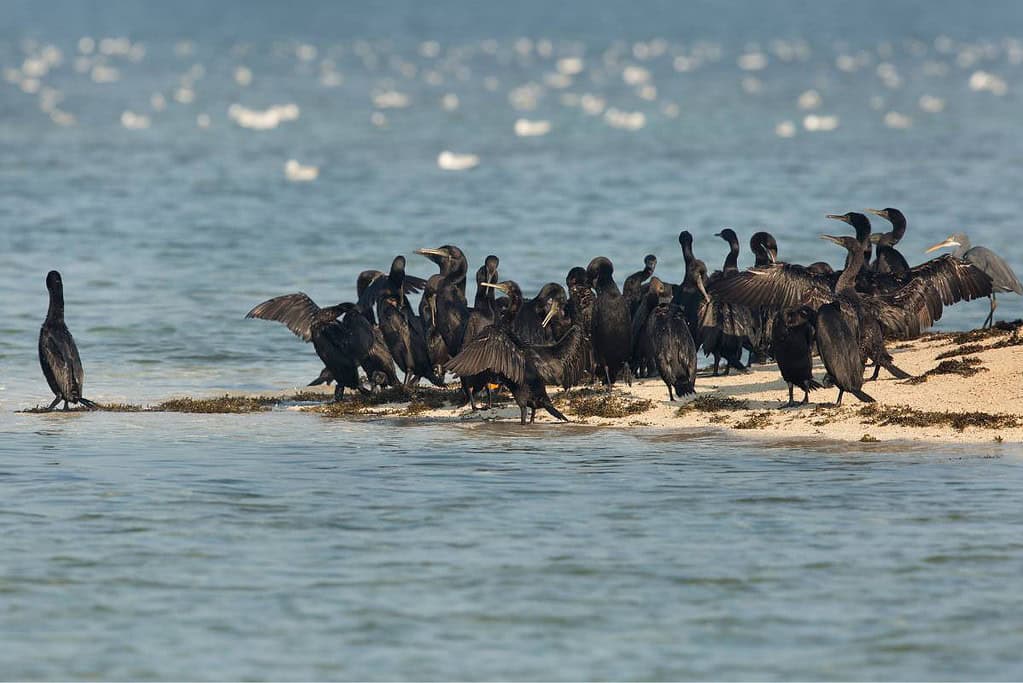
The Dragon Blood Tree
The Dragon Blood Tree, scientifically known as Dracaena cinnabari, is one of the most iconic and recognizable trees on Socotra Island. Its name is derived from the red sap that drips from the trunk and branches, which is said to resemble dragon’s blood.

The tree has a unique, umbrella-shaped canopy and can grow up to 15 meters tall, making it a stunning sight against the island’s rugged landscape. Beyond its distinctive appearance, the Dragon Blood Tree is also a valuable source of medicinal and cosmetic products, with its sap used for various purposes, such as dyeing textiles and treating wounds.
With a history that dates back to ancient civilizations, the Dragon Blood Tree is a symbol of the rich cultural heritage of Socotra Island. Whether you’re a hiker, nature lover, or history buff, the Dragon Blood Tree is a must-see for anyone visiting Socotra Island.
7 Characteristics of the Unique Dragon Blood Tree:
- Unique appearance: The Dragon Blood Tree is known for its unique, umbrella-shaped canopy and its distinctive red sap, which gives it its name.
- Adaptability: This tree is capable of thriving in harsh conditions, including high winds, high temperatures, and drought.
- Endemic species: The Dragon Blood Tree is endemic to the island of Socotra, located off the coast of Yemen, and is found nowhere else in the world.
- Medicinal properties: The sap of the Dragon Blood Tree has been used for centuries for its medicinal properties, including wound healing and as a treatment for various skin conditions.
- Threatened species: The Dragon Blood Tree is considered a threatened species due to over-harvesting and habitat destruction.
- Cultural significance: The tree holds significant cultural value for the local people of Socotra, who have used it for traditional medicines and as a source of dye for centuries.
- Ecological importance: As a keystone species, the Dragon Blood Tree plays an important role in the ecosystem of Socotra, providing habitat and food for a variety of plant and animal species.
The Dragon Blood Tree is native to Socotra Island and has evolved to thrive in its unique and harsh environment. The island is located in the Indian Ocean and is considered a biodiversity hotspot due to its isolation from the mainland, which has allowed for the evolution of a distinct and diverse array of species.
The Dragon Blood Tree is one of the many endemic species on the island, and its presence is due to the combination of the island’s hot, arid climate and its rugged terrain, which provides the tree with the ideal conditions for growth.
Over time, the tree has become a keystone species on the island, playing an important role in the ecosystem by providing shade and food for wildlife, as well as helping to prevent soil erosion. With its unique beauty, rich cultural history, and important ecological role, the Dragon Blood Tree is a symbol of the unique and vibrant nature of Socotra Island.
History and Culture
Socotra Island boasts a rich and diverse history and culture, shaped by its unique geography and location at the crossroads of major trading routes in the Indian Ocean.
Throughout its history, the island has been inhabited by various civilizations, including the ancient Egyptians, Greeks, and Arabs, who have all left their mark on the island’s culture and traditions. The island’s isolation has also allowed for the development of a distinct cultural identity, with its own language, music, and customs.
Today, the island’s population is primarily composed of the indigenous Soqotri people, who continue to maintain their traditional way of life, relying on fishing, animal husbandry, and agriculture for their livelihoods. Despite the challenges posed by its harsh environment, the island’s rich history and cultural heritage make it a unique and fascinating place, offering a window into the vibrant and diverse traditions of the Indian Ocean region.
Timeline of Significant Events in the History of Socotra Island:
- First human settlement: Socotra is believed to have been inhabited by humans for thousands of years, with evidence of early human settlements dating back to the third millennium BCE.
- Arrival of the Greeks: The island was visited by Greek traders in the 3rd century BCE, who established trade routes with the island’s indigenous peoples.
- Occupation by the Romans: Socotra became part of the Roman Empire in the 1st century CE, and remained under Roman control until the end of the empire in the 5th century.
- Islamic Conquest: The island was conquered by Arab forces in the 7th century, and became part of the Islamic world.
- Portuguese occupation: The Portuguese occupied the island in the 16th century, and established a fort on the island.
- British Protectorate: Socotra became part of the British protectorate in the late 19th century, as part of Britain’s attempts to establish a presence in the Arabian Peninsula.
- World War II: The island was occupied by the British during World War II, and served as an important base for Allied operations in the region.
- Independence from Britain: Socotra became part of South Yemen when Britain withdrew from the region in 1967, and was later incorporated into the unified Yemeni Republic in 1990.
- Cyclone hit: In 2008, the island was hit by a severe cyclone, which caused significant damage to its infrastructure and environment.
- Unesco World Heritage Site: In 2008, Socotra was designated as a UNESCO World Heritage Site, recognizing its unique biodiversity and cultural significance.
The People of Socotra
Socotra Island is home to a unique and vibrant community of people known for their rich cultural heritage and history. The island has been inhabited for thousands of years and has a long history of seafaring and trade, which has influenced its people and their traditions.
The island’s isolation has also allowed for the preservation of its indigenous language, customs, and beliefs, which are deeply rooted in the island’s natural environment and its rich history. Despite facing challenges posed by its remote location and harsh environment, the people of Socotra are resilient, resourceful, and proud of their unique identity and culture.
Whether through their traditional crafts, music, or cuisine, the people of Socotra offer a fascinating glimpse into the island’s rich cultural heritage and history.
Language and Traditions
Socotra Island, located in the Indian Ocean, is home to a unique and diverse culture that has developed over centuries of isolation. The island is inhabited by the Socotri people, who speak their own distinct language and practice traditional customs that have been passed down through generations.
These traditions include traditional music, dance, and the production of unique crafts and goods, such as baskets and pottery, which are still produced and used by the local community today. The cultural heritage of Socotra is an important aspect of the island’s identity and provides a connection to its rich history and heritage.
With its vibrant culture and rich history, Socotra Island offers a fascinating insight into the diversity of the world’s cultures and is a testament to the resilience and ingenuity of its people.
Socotri is a South Arabian language spoken on the island of Socotra, which is located in the Indian Ocean. It is a member of the South Arabian subgroup of the Semitic languages and is closely related to the Modern South Arabian languages such as Mehri and Shehri.
The language is considered to be one of the most endangered languages in the world, with an estimated 8,000 to 10,000 speakers. Despite its declining number of speakers, Socotri remains an important part of the cultural heritage of the Socotra Island population and is a valuable resource for linguistic and cultural research.
Socotra Food
There are also a variety of Socotra food options available, including local dishes made with fresh seafood and vegetables, as well as international cuisine.
10 Must-Try Dishes from Socotra Island:
- Machboos: A spicy rice dish made with chicken or fish, tomatoes, onions, and a blend of spices.
- Harees: A traditional dish made from ground wheat and meat, typically served during Ramadan or special occasions.
- Salta: A thick, hearty soup made with lentils, potatoes, and spices.
- Stuffed Camel: A dish made from a whole roasted camel, stuffed with rice, spices, and nuts.
- Balaleet: A sweet pudding made with vermicelli noodles, sugar, and cardamom.
- Zalabia: A sweet fried pastry made with honey, sugar, and spices.
- Mathbi: A grilled flatbread made with ground barley and spices.
- Shuwa: A slow-cooked meat dish, typically made with goat or beef, and flavored with spices, herbs, and coconut milk.
- Machbous Salam: A spicy seafood dish made with shrimp, calamari, and a blend of spices.
- Roasted Goat: A traditional dish made by roasting a whole goat over an open fire, flavored with spices, herbs, and garlic.
Why Visit Socotra Island

Socotra Island is a unique and captivating destination, offering travelers an escape from the modern world and a chance to immerse themselves in a vibrant and diverse ecosystem. From its stunning beaches and towering cliffs, to its rare and endemic species of plants and animals, Socotra is a true natural wonder.
Visitors can participate in eco-tours to learn about the island’s rich cultural history, explore its rugged terrain, and appreciate its unique and pristine environment. Whether you’re a nature lover, adventurer, or simply looking for a change of pace, Socotra is the perfect destination to escape the ordinary and experience something truly special.
Traveling to Socotra Island and exploring its breathtaking landscapes, from the remote beaches to the rugged mountains, is a unique experience. Visit the capital city of Hadibo, where you can immerse yourself in the local culture and learn about the island’s rich history. Book a stay at a Socotra hotel, where you can relax and rejuvenate after a day of adventure.
From September to May, you can take advantage of the weekly flights from Abu Dhabi to Socotra, which offer the opportunity to experience the island’s unique beauty. Whether you prefer a scheduled tour or a private tour, there are many Socotra tours to choose from, including socotra trek tours and socotra fishing tours.
If you’re looking for a truly unique holiday experience, consider a 7-day Socotra family adventure itinerary. This Socotra travel itinerary will allow you to explore the island’s stunning natural beauty, including the unique Socotra island animals, and immerse yourself in its rich cultural heritage. Discover why Socotra is known as the paradise of nature and why travel to Socotra should be on your bucket list.
For adventure, culture and relaxation, attracting tourists from all over the world. If you’re planning a trip to Socotra, here’s everything you need to know about Socotra travel.
Socotra Island is a haven for nature lovers and adventure seekers, with its diverse landscape and rich wildlife. One third of the plant life on the island can only be found here, and visitors can spot unique species of animals such as the Socotra starling, the Socotra sunbird, and the Socotra dragon. The island also offers opportunities for activities such as camping, hiking, wildlife spotting, and cultural immersion.
There are several tour options available for those visiting Socotra, including scheduled tours and private tours that run from September to May. Visitors can choose from a variety of activities, such as beach vacations, trek tours, fishing trips, and Socotra capital tours. A popular choice is the Socotra family adventure itinerary, which is a 8-day itinerary that provides a comprehensive and unique experience of the island’s beauty.
Attractions and Activities
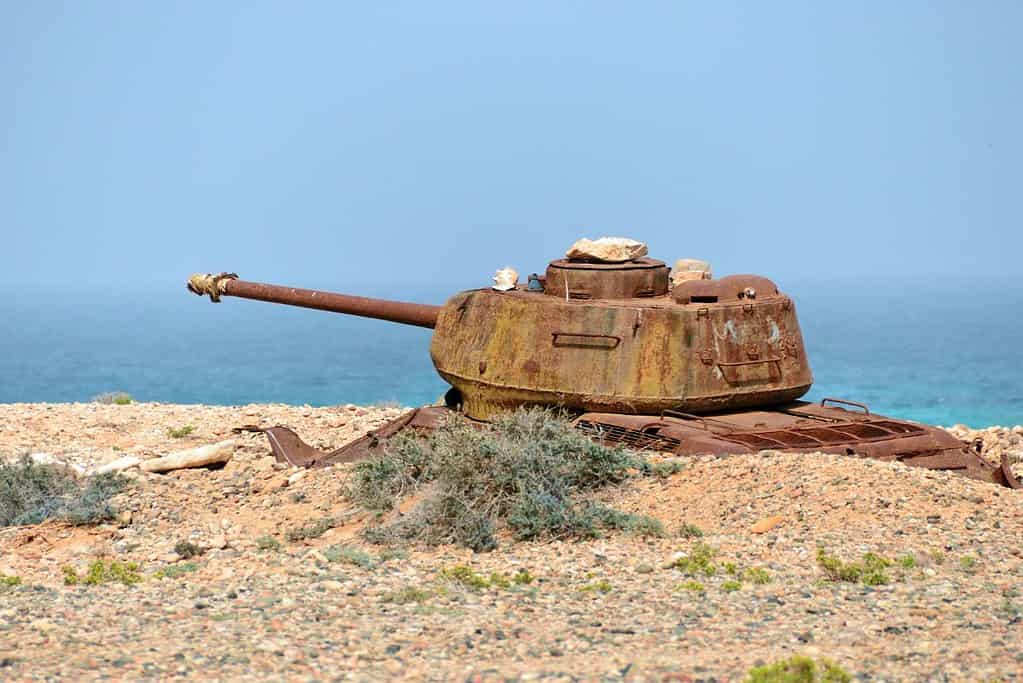
To visit Socotra Island is quite easy, because it is a destination that offers an array of attractions and activities for visitors. From exploring its diverse ecosystems and rich cultural history to experiencing its unique cuisine and vibrant local traditions, there’s something for everyone on this idyllic island.
Whether you’re seeking adventure and excitement or looking to relax and unwind, Socotra Island offers a range of activities including hiking, snorkeling, and beachcombing. With its stunning landscapes and natural beauty, visitors can also enjoy breathtaking views and sunsets, and indulge in local customs such as markets and festivals. With so much to offer, Socotra Island is the perfect place for travelers who want to experience the beauty of nature and the richness of local culture.
7 Must-See Attractions of Socotra Island:
- Dragon’s Blood Trees: The unique and iconic Dragon’s Blood Trees are one of the most recognizable attractions on Socotra.
- Beaches: Socotra boasts some of the most beautiful and pristine beaches in the world, with crystal-clear waters and soft, white sand.
- Caves: The island is home to a number of caves, including the Al Shouf Cave, which is the largest cave system on the island.
- Wildlife: Socotra is home to a number of unique species of flora and fauna, including the Socotra Rock Gecko, the Socotra Sunbird, and the Socotra Warbler.
- Ancient villages: The island is home to a number of traditional villages, including Hadibo, the largest city on the island, which offers a glimpse into the island’s rich cultural heritage.
- Hiking trails: The island offers a number of beautiful and challenging hiking trails, including the Hoq Cave Trail, which provides breathtaking views of the island’s coastline.
- Scuba diving: Socotra is a popular destination for scuba divers, offering a wealth of underwater life and vibrant coral reefs, including the popular Dixam Plateau dive site.
What to visit in Socotra




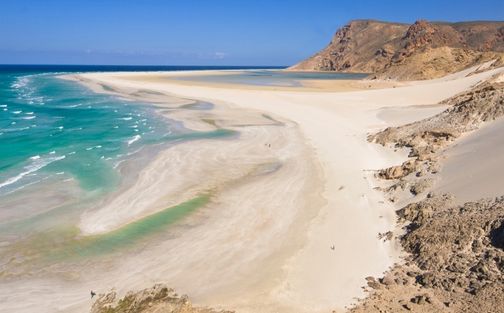

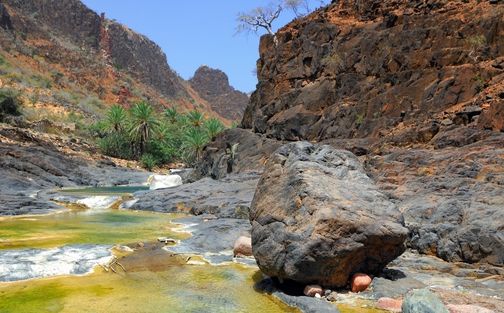
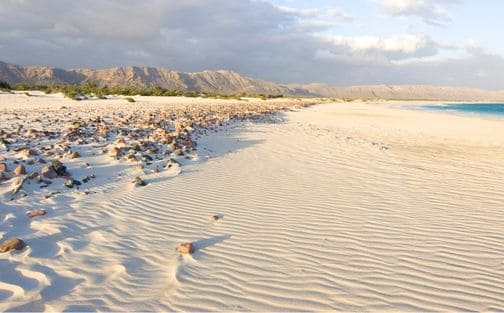



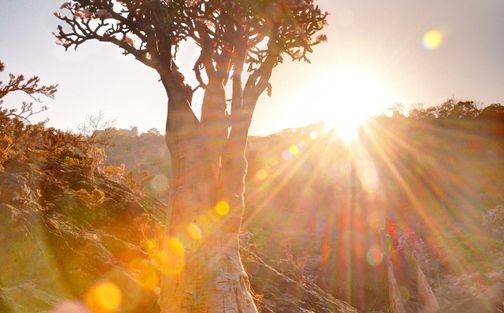


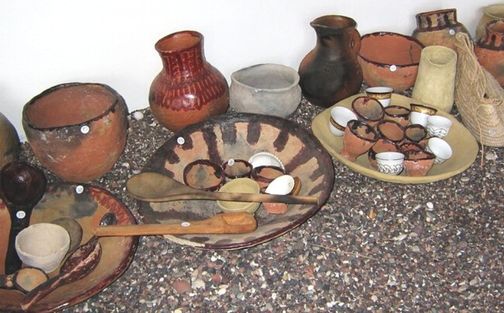
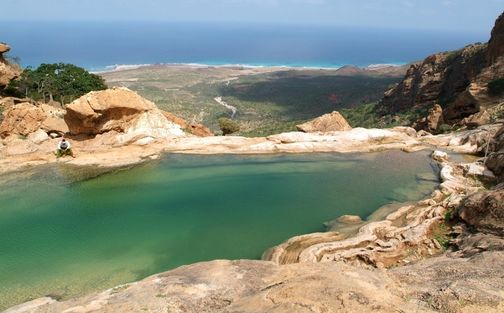



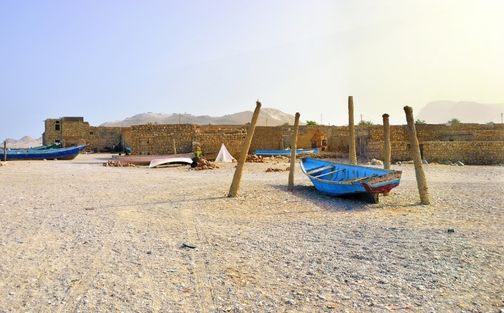
Beaches and Scenery
Socotra Island boasts breathtaking beaches and stunning scenery. With its crystal clear waters and pristine white sand, visitors can relax and soak up the sun or engage in various water sports activities. The island is also home to a unique and diverse landscape, including rugged cliffs, towering dunes, and lush vegetation.
These natural wonders, combined with its remote location in the Indian Ocean, make Socotra Island beach time a true paradise for those seeking an eco-adventure and a chance to escape the hustle and bustle of daily life. Whether exploring the island on foot or by boat, visitors will be captivated by the stunning beauty of its breathtaking scenery and idyllic beaches.
10 Stunning Beaches to Visit in Socotra Island:
- Dihamri Beach
- Homhil Beach
- Shoab Beach
- Nasab Beach
- Dixsam Plateau Beach
- Tamr Henna Beach
- Al Maron Beach
- Delisha Beach
- Qalansiya Beach
- Kharaz Beach
Nature Reserves
Socotra Island is home to several nature reserves, which serve as important habitats for the island’s unique and diverse array of plant and animal species. These reserves are designated as protected areas, and they play a critical role in conserving the island’s natural beauty and biodiversity.
With its rugged landscapes, pristine beaches, and breathtaking scenery, the nature reserves of Socotra Island offer visitors a chance to experience the island’s natural wonders up close and personal. Whether you’re interested in birdwatching, hiking, or simply taking in the stunning views, the nature reserves of Socotra Island provide a memorable and unforgettable experience for all visitors.
10 Must-Visit Reserves and Parks in Socotra Island:
- Socotra Archipelago Marine Reserve
- Socotra Island National Park
- West Hajhir Mountains Reserve
- Calors Mountain Reserve
- Shouab Reserve
- Adho Reserve
- Al Mayzoon Reserve
- Homhil National Park
- Ayhaft Canyon National Park
- Dihamri Marine Reserve
Socotra Travel Information
Socotra Island is a remote and exotic destination, located in the Indian Ocean. Traveling to the island can be challenging, as there are limited flights and transportation options, but the effort is worth it for those seeking an adventure and a chance to explore the unique and unspoiled natural beauty of the island.
To make the most of your trip, it’s important to plan ahead and be well-prepared, with a good understanding of the local culture and customs, as well as the logistics of getting around and finding accommodations. With careful planning and an open mind, a visit to Socotra Island can be a truly unforgettable experience.
The island is home to around 70,000 people who speak their own native Socotri language, and the main town is Hadibo. However, despite its population, the island has limited infrastructure, making it the perfect place for camping, walking, hiking, wildlife spotting, and cultural immersion.
Also read:
Socotra Tours
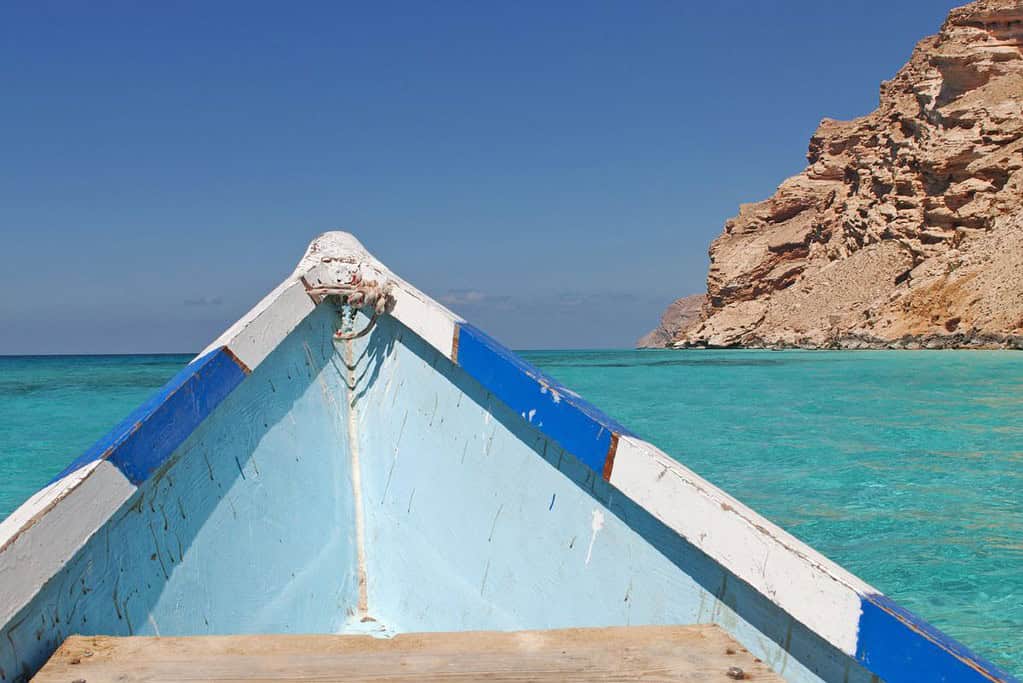
Socotra Island offers an exceptional eco-tourism experience for those seeking to immerse themselves in nature and discover the unique and diverse flora and fauna of the region. The island is home to an array of endemic species, including the famous Dragon Blood Tree, and its isolation from the mainland has allowed for the evolution of a distinct and diverse array of wildlife and plant life.
Visitors can take guided tours of the island, exploring its rugged terrain, visiting ancient caves and rock formations, and observing its diverse wildlife. The focus on eco-tourism on Socotra Island not only provides visitors with a unique and unforgettable experience, but also helps to preserve the island’s delicate ecosystem, allowing it to continue to thrive for generations to come.
Our Socotra tours special edition includes exploring fascinating places such as Alalmah, Detwah Lagoon, Qalansyai, Shoub Beach, Rokeb Farmhin, Degub cave, Omaq Beach, Hayf and Zahak Dunes, Momi plateau, Kelesehan Canyon, Wadi Farho, Arher Beach, Ras Erisal, Homhil National Park, and the fabulous Delisha Beach.
8-day Socotra Island tours
Day 1 » Arrival at Socotra » Alalmah » Detwah Lagoon
Day 2 » Detwah Lagoon » Qalansyai » Shoub Beach boat trip » Qalansyai » Detwah Lagoon
Day 3 » Qalansyai » Diksam plateau » Shebahon viewpoint » Rokeb Farmhin Forest
Day 4 » Rokeb Farmhin Forest » Degub cave » Omaq Beach » Hayf and Zahak Dunes » Omaq Beach
Day 5 » Omaq beach » Momi plateau » Kelesehan Canyon » Wadi Farho » Arher Beach
Day 6 » Arher » Cave exploration » Ras Erisal » Arher
Day 7 » Arher » Homhil National Park » Dihamri Marine Protected Area » Delisha Beach
Day 8 » Delisha Beach » Airport transfer » Departure from Socotra » End of services.
Accommodation
Tourists can enjoy dining at local restaurants, or opt for more private dining experiences in their accommodations. Whether you’re looking for a basic place to rest or a more luxurious stay, Socotra Island has something to offer.
Socotra tourism in terms of accommodation offers a limited range of options, from wild camping, and simple guesthouses to basic beach lodges. Above all, what the tourism Socotra industry business tries to promote is eco-tourism. This means that the impact of Socotra island tourism on the environment should be minimal, so that the natural beauty and ecosystem of the island are preserved for future generations. The goal is to allow tourists to enjoy the island’s unique flora and fauna while ensuring that their presence has no negative effects on the environment.
Socotra hotels are indeed restricted in terms of variety and mostly targeted at eco-tourists. In Hadibo, there are hotels like Summerland Hotel (4-star), Socotra Tourist Hotel, Socotra Island Hotel, and Taj Socotra Hotel, with modern rooms, AC, TV, fridge, private/shared bathrooms and laundry. For another type of Socotra hotel there is also an eco-lodge run by Adib’s family, offering woven huts and shaded resting areas.
Hotels on Socotra Island are also outstretched into 6 eco-campsites run by local communities, like Amak on a white sandy beach, Dihamri on the shore of a coral reef, Homhil in the magic land of dragon blood trees, and Skand at the foot of Jebel Skand. Adeeb’s eco-lodge offers huts and tents and is located near a pebbles beach outside of Hadibo.
Also read:
How to Get to Socotra Island
Socotra Island can be reached by air travel. The island has a small airport, with flights available only from Al Mukalla in Yemen and Abu Dhabi in the United Arab Emirates.
The once monsoon-restricted archipelago of Socotra is now accessible year-round thanks to the opening of Socotra Island Airport in July 1999. Conveniently located just 12 km west of the main city of Hadibo.
To reach this breathtaking destination, and how to travel to Socotra airport, you have to take the airplane from from Abu Dhabi every Tuesday.
RJ Travel offers both scheduled and private tours to the exotic island of Socotra every week from September to May. The flights depart from Abu Dhabi every Tuesday, providing a convenient and reliable means of transportation to the island.
Please note that flights to Socotra Island are limited, with only one per week, travelers must stay on the island until the next flight. As a result, the tour length is fixed at 8 days to ensure you have ample time to explore Socotra.
Before traveling, it’s essential to check the latest travel advisories and requirements, including visas and vaccinations, to ensure a safe and enjoyable trip to this unique and beautiful island.
Socotra Island flight schedule and prices

Air Arabia flight schedule
Air Arabia operates a weekly direct flight between Abu Dhabi and Socotra, taking off every Tuesday. The flight number 476 departs from Abu Dhabi (AUH) at 9:25 AM and arrives in Socotra (SCT) at 10:40 AM. The return flight number 477 departs from Socotra (SCT) at 12:10 PM and arrives in Abu Dhabi (AUH) at 3:25 PM.
Yemania Airways flight schedule
Yemenia Airways operates a weekly direct flight between Al Mukalla city and Socotra, taking off every Monday. The flight departs from Al Mukalla Riyan International Airport (RIY) at 9:00 AM and arrives in Socotra (SCT) at 10:00 AM. The return flight departs from Socotra (SCT) at 12:00 PM and arrives in Al Mukalla (RIY) at 1:00 PM.
Disclaimers on Socotra Flights
RJ Travel tour operator is a facilitator for travel to Socotra Island, and as such, it is not responsible for changes or updates to flight schedules or prices. RJ Travel tour operator provides land-based travel services and does not have jurisdiction over flight schedules or prices.
The company cannot be held responsible for any loss or inconvenience resulting from how to fly to Socotra, and consequent changes or updates. RJ Travel cannot be held responsible for any loss or inconvenience resulting from these external factors related to flights and weather affecting these same flights to Socotra.
Any changes or updates to flight schedules, delays or cancellations, are the responsibility of the airline and not within the control of RJ Travel.
It is important for travelers to understand that flight-related issues fall outside the scope of RJ Travel’s responsibility and to communicate directly with their airline for any related concerns. It is important for travelers to be aware of this limitation of responsibility and to stay informed of any updates or changes to their travel plans.
Safety Information
Socotra Island is considered a safe destination for travelers, however, it is important to take necessary precautions and be aware of local customs and laws. Visitors should exercise caution when venturing into isolated areas, and be mindful of the island’s unique wildlife and landscape.
Travelers should also ensure they have adequate travel insurance coverage and familiarize themselves with the island’s medical facilities and emergency services. To ensure a safe and enjoyable trip, it is advisable to research and plan ahead, and be mindful of one’s surroundings while exploring this unique and beautiful island.
Rules & Code of Conduct
To protect the unique ecosystem of Socotra Island, we ask all visitors to abide by the following rules:
- Respect the natural environment by avoiding activities that harm wildlife, breeding grounds, plants, and their habitats. Use only brushwood as fuel for fires.
- Properly dispose of waste, including cigarette butts and litter.
- Respect the privacy of residents and only enter their spaces or take photos with permission.
- Avoid drinking alcoholic beverages in public places and being loud inside caves.
- Do not bring in or take out any biological material, souvenirs, or natural resources from the island. Follow the advice of your guide before swimming in the sea or rivers.
- Do not touch or damage corals, and avoid collecting shells, flora, and fauna samples. Do not feed fish as it creates dependency and harms the ecosystem.
FAQ
Is Socotra safe for tourists?

Socotra Island is a safe and secure destination for tourists, with a number of factors contributing to its overall safety.
Firstly, the island has a low population, meaning that it is not densely populated and has a more relaxed and peaceful atmosphere.
Secondly, the local people are known for being friendly and welcoming to visitors, creating a warm and hospitable environment.
Finally, Socotra Island has a strong Islamic tradition, which not only influences the culture and way of life on the island, but also contributes to the overall stability and security of the area.
What is so special about Socotra Island?

Socotra Island is special and important because it’s isolated from other places.
This has helped create a one-of-a-kind environment with lots of plants and animals you can’t find anywhere else in the world.
The most famous is the Dragon Blood Tree, which only grows on the island.
Can you stay on Socotra Island?
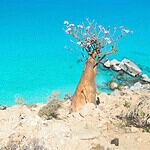
When you visit Socotra, you’ll have a few choices for where to stay. You can camp in nature, stay in simple guesthouses, or stay in beach lodges.
The hotels on the island are mostly for people who like to be close to nature, so there aren’t a lot of choices.
In Hadibo, there are some nice hotels like Summerland Hotel, Socotra Tourist Hotel, Socotra Island Hotel, and Taj Socotra Hotel. They have comfortable rooms with air conditioning, TV, a fridge, and private or shared bathrooms.
Can Americans travel to Socotra Island?

If you’re an American, you can go on a trip to Socotra.
Our company RJ Travel, takes Americans tourists on tours to Socotra.
We make sure you get a Yemen visa, which lets you visit the country, and it’s included in the price of our Yemen tour packages. So you don’t have to worry about extra costs.
How to visit Socotra island?

Socotra Island is accessible by air travel with a small airport offering flights from Al Mukalla in Yemen and Abu Dhabi in the UAE.
However, flights to Socotra are limited to only one per week, meaning travelers must spend 8 days on the island to fully explore it.
Air Arabia operates a direct flight from Abu Dhabi to Socotra every Tuesday while Yemania Airways operates a direct flight from Al Mukalla to Socotra every Monday
Where is Socotra island?
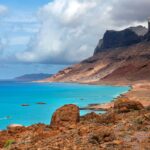
Socotra, an archipelago located 150 miles off the Horn of Africa in the Gulf of Aden, is officially part of Yemen. Socotra Island makes part of a group of four islands, and it’s the largest one in the Socotra Archipelago.
Who owns Socotra island?
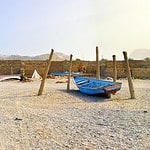
Socotra Island is part of Yemen and is administered by the Yemeni government.
Although is officially part of Yemen, but has been under the control of the United Arab Emirates for several years.
Socotra has been part of Yemen since the country was formed in 1990 with the unification of North and South Yemen. Before 1990, Socotra was under the control of South Yemen, which was a Marxist state known as the People’s Democratic Republic of Yemen.
Is Socotra part of UAE?
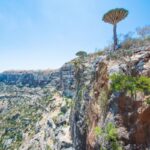
Socotra is officially part of Yemen, but has been under the control of the United Arab Emirates for several years.
The situation regarding the presence of the United Arab Emirates on Socotra Island is complex and politically sensitive.
In 2018, the UAE deployed troops to the island, causing tensions with the Yemeni government. Prior to this, the UAE had been providing aid and relief through humanitarian organizations such as Emirates Red Crescent, and had established a military base on the island as part of the Saudi Arabian-led intervention.
However, some Yemeni political factions have accused the UAE of attempting to occupy the island and causing harm to its unique ecosystem.


